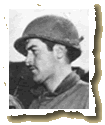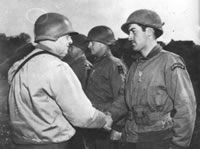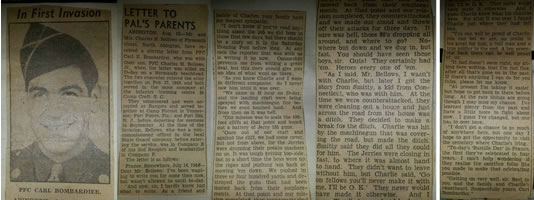| The Assault | Timeline | Maps | Men of D-Day | Photos |

|
This article was submitted in 1994 to the Brockton Enterprise for the 50th Anniversary of the Normandy Invasion by the son of Carl E. Bombardier of the 2nd Ranger Battalion, Captain Leon A. Bombardier, US Army Corps of Engineers. Two Abington, Massachusetts residents participated in the D-Day invasion on June 6, 1944, as members of the 2nd Ranger Battalion; Pfc Carl E. Bombardier and Pfc Charles H. Bellows Jr. In the tradition of the British Commandos under the "buddy" system, the two young men joined the newly formed 2nd Ranger Battalion activated at Camp Forrest, Tennessee on April 1, 1943. After 14 months of intense training and at the young age of 20 years, they were involved in the Normandy invasion at Pointe du Hoc. The mission of D, E, and
F Companies of the 2nd Ranger on D-Day was to secure the coastal
artillery battery located on top of the cliffs of Pointe du Hoc,
strategically situated between Omaha and Utah beaches and of cutting
the road running behind the Pointe from Saint-Pierre-du-Mont to
Grandcamp. The Germans believed the position at Pointe du Hoc as impregnable from seaward attack. Machine guns and antiaircraft guns were set up on each flank. The landward approaches were defended with mines and barbed wire. The emplacement was defended elements of the German 352nd Infrantry Division with more than 200 infantry and artillerymen, members of the German 726th Infantry Regiment, 716th Infantry Division and the 2nd Battery, 832nd Army Coastal Battalion. On the morning of June 6th Carl Bombardier remembered leaving the British Channel steamer H.M.S. Ben Machree for the LCA assault craft. "It was a foggy, overcast morning," Carl recalled for Proctor & Gamble Company magazine published on the 25th anniversary, "The seas were rough and some of the boats were taking on a lot of water and some of them were even swamped. Unlike many of the other landing forces not used to the heavy seas, most of us weren't bothered too much by seasickness. We carried only thermite grenades, carbines, automatic rifles and M-1's and limited food supplies with us. I think that the only food I took along was a chocolate bar from my D-ration. Our mission was to land on the beach below Pointe du Hoc, climb to the top of the 100-foot-high cliffs by rope ladders fired from rocket launchers into the side of he cliff, and knock out six French 155 mm guns that were capable of reaching targets along Utah and Omaha beaches where the invasion would soon take place. We had about one hour to land, secure the cliff and set up a defense before the actual invasion began. "Three of the companies (mine was F Company) (the other two being D and E Companies) were assigned to go in first. If we were successful in taking the cliffs and establishing a position in the prescribed time, the other three companies (A,B,C Companies) would follow up as support. Well, first of all, we were headed toward Pointe de la Percee on the wrong course, and, consequently, lost our element of surprise. The Germans saw what we were up to and lobbed shells at us as we headed west to Pointe du Hoc. When we finally landed, after two hours in the water, the fire was heavy. Our BAR man was the first one our of the boat and was hit by machine gun fire immediately. Most of us hustled out of the boats and managed to find some protection at the base of the cliff. Each boat had six rope ladders to fire into the rocky side of the hill. Out of half a dozen we got only one secured at the top of the cliff. I remember that ,our hands were numb from the icy sea water and the wet rope was tough to climb. Luckily for us, two men made it up on another side of the cliff and held off the Germans while the rest of us scrambled to the top. The enemy didn't make it easy though, they cut down some of the ladders, tossed grenades over the cliff and machine gunned the troops as they scaled the rocky hillside. The heavy shelling from the U.S. Navy boats had done a good job of reducing their firepower before we landed, and the shell holes on top of Pointe du Hoc reminded me of moon craters, they were so big. We jumped into these holes for cover once we got to the top. I guess it took us 15 to 30 minutes to get to the top, but by the end of the day, only about 90 out of 225 Rangers were still able to fight. In addition, our late start meant that we had lost our support; A, B, and C Companies and the 5th Ranger took off for the beaches in other directions, so we were all alone up there. After the hour of battle it became a mere matter of survival. "It was difficult to know where our lines were, there was no telling if the enemy was behind you, in front of you or on either side of you. There was no established defense perimeter or even a command post at first. What was most disheartening was that the Germans had moved the big guns to another position further inland because of the heavy bombardment from the sea and from the air. As other Ranger units advanced about a mile inland, however , the guns were found in a concealed area and destroyed, so our mission was accomplished after all. Without replacements, we held fast a Pointe du Hoc for three days until the overall Allied advance from Utah and Omaha expanded to meet our own lines."
Sergeant Leon H. Otto was also killed at Pointe du Hoc, my father's squad leader, for whom I was named. Carl E. Bombardier finished
the war in Pilsen, Czechoslovakia -the only member of his platoon
to do so. The father of 9 children, he died of a heart attack in
Abington, Massachusetts on July 2, 1976. This story is published with the permission of Carl Edward Bombardier's Son : Leon A. Bombardier. |
| |

 Carl
Bombardier joined the army with his hometown friend Charlie Bellows
as volunteers in 1942. They later joined the 2nd Ranger together
in 1943. Charlie Bellows reached the top of the cliffs with members
of his unit E Company and was reported to be involved in action
against one of the fortified gun positions. Pfc Bellows was later
killed at Pointe du Hoc. Bellows Circle off Plymouth Street, Abington
bears his name.
Carl
Bombardier joined the army with his hometown friend Charlie Bellows
as volunteers in 1942. They later joined the 2nd Ranger together
in 1943. Charlie Bellows reached the top of the cliffs with members
of his unit E Company and was reported to be involved in action
against one of the fortified gun positions. Pfc Bellows was later
killed at Pointe du Hoc. Bellows Circle off Plymouth Street, Abington
bears his name.